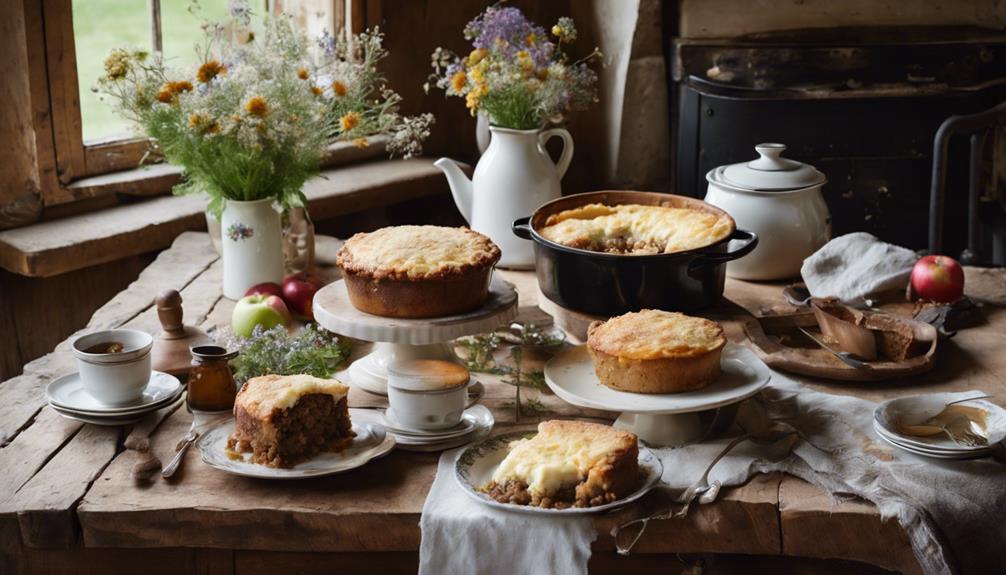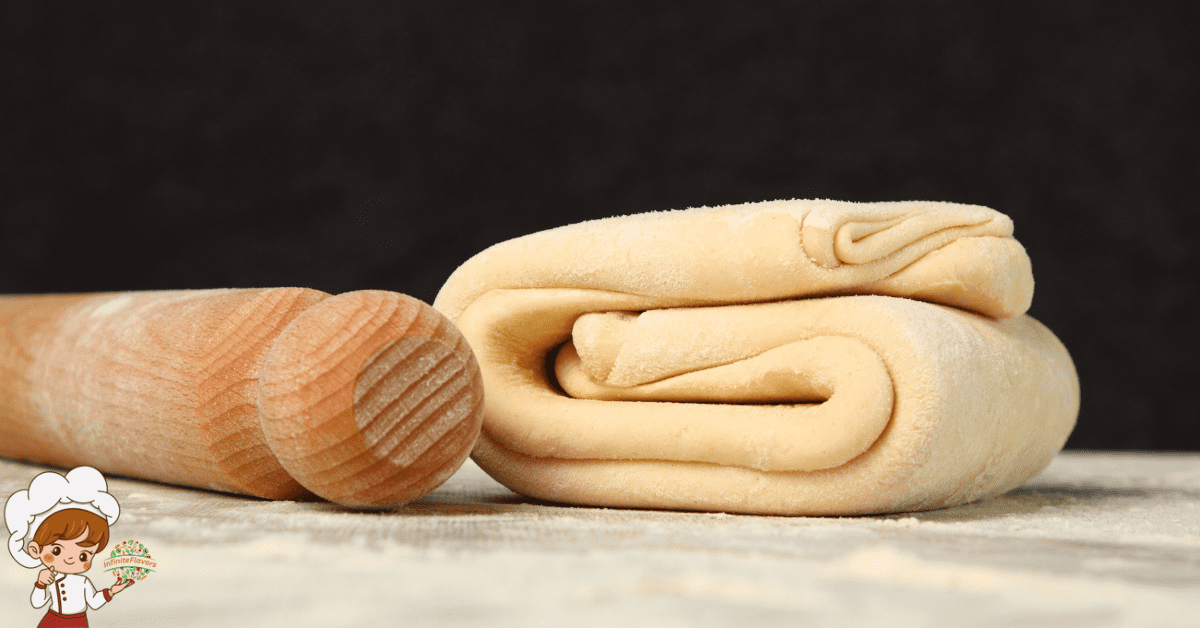10 Of The Best Traditional British Farmhouse Recipes

If you’re looking for the 10 best Traditional British Farmhouse Recipes, you’ve come to the right place. Start with Shepherd’s Pie, a hearty mix of lamb and creamy mashed potatoes. You won’t want to miss Beef Wellington, our tender beef wrapped in flaky pastry. Try Cornish Pasties for a savory treat on the go, and don’t forget about classic Bangers and Mash. Warm yourself with Welsh Cawl or Toad in the Hole. For dessert, Sticky Toffee Pudding and Bread and Butter Pudding won’t disappoint you. Keep exploring, and you’ll discover even more comforting options.
Shepherd’s Pie
Shepherd’s Pie warms the soul with its hearty blend of meat and vegetables, all topped with creamy mashed potatoes. This beloved dish traditionally uses minced lamb, offering a rich and savory flavor that’s hard to resist. If you want to elevate your pie, consider experimenting with different lamb options. You might try using ground lamb for a classic approach, or explore shank or shoulder cuts for a more nuanced taste.
As you prepare your pie, think about the vegetables you’ll include. Carrots, peas, and onions are popular choices, but you can easily customize your filling to suit your preferences. A touch of Worcestershire sauce or a sprinkle of fresh herbs can add depth to the flavor.
When it comes to pie variations, don’t shy away from creativity. While the traditional version holds a special place in the hearts of many, you can substitute the lamb with beef or even a mix of vegetables for a vegetarian twist. Each variation offers a unique take on comfort food, allowing you to cater to different tastes.
As you layer your ingredients and spread that fluffy mashed potato topping, you’re not just making a meal; you’re creating a warm experience to share with loved ones. So, gather your ingredients, preheat your oven, and look forward to serving a delightful Shepherd’s Pie that’ll have everyone coming back for seconds!
Beef Wellington
Now that you’ve enjoyed a hearty Shepherd’s Pie, let’s turn our attention to Beef Wellington. You’ll need to gather some key ingredients and follow specific preparation tips to get it just right. We’ll also explore the cooking techniques that make this classic dish truly shine.
Ingredients and Preparation Tips
Beef Wellington is a classic dish that brings together tender beef fillet, a rich mushroom duxelles, and flaky pastry for an impressive centerpiece. To create the perfect Beef Wellington, start with high-quality seasonal ingredients. Choose a fresh beef fillet, ideally grass-fed for the best flavor. For the duxelles, use finely chopped mushrooms, shallots, and fresh herbs, which you’ll sauté until caramelized. This step enhances the depth of flavor.
When it comes to preparation methods, make certain your beef is seared to lock in moisture and flavor. After searing, let it cool before wrapping it in prosciutto and the mushroom mixture. This keeps the pastry from becoming soggy. Use a good-quality puff pastry; it’s key to achieving that delightful flaky texture. Roll it out thinly and chill it before wrapping the beef.
Lastly, remember to brush the pastry with egg wash for that golden finish. Cooling the wrapped Wellington in the fridge for a short time before baking can help the pastry maintain its shape. With attention to these details, you’ll create a show-stopping Beef Wellington that’s sure to impress your guests.
Cooking Techniques Explained
Creating a perfect Beef Wellington relies heavily on precise cooking techniques that elevate each component of the dish. Start by sautéing vegetables like mushrooms and shallots to develop a rich flavor base. Once they’re cooked down, let them cool before layering them over the beef. When preparing your meat, consider braising it lightly to enhance tenderness and flavor, then sear it for a beautiful crust.
Next, focus on your pastry. Use roasting techniques to guarantee a golden, flaky exterior. The beef should be wrapped tightly in the pastry to lock in moisture. While waiting for the Wellington to bake, you might want to prepare a side of blanched greens to add freshness to the meal.
For the perfect sauce, simmer stocks made from roasted bones and aromatic vegetables, creating a deep, savory complement to your dish. If you’re feeling adventurous, you can also serve poached eggs on the side for an elegant touch. Remember, mastering these techniques will not only make your Beef Wellington shine but also enhance your overall cooking skills. Enjoy the process, and savor each bite!
Cornish Pasty
Originating from the rugged landscapes of Cornwall, the Cornish pasty is a hearty pastry filled with a savory blend of ingredients. This beloved dish has deep roots in Cornish history, dating back to the 13th century when miners needed a portable meal. The pasty’s sturdy crust served as a convenient handle, protecting the filling from dirt while allowing miners to enjoy a nutritious lunch.
You’ll find various pasty variations across the UK, showcasing regional influences. While the traditional Cornish pasty typically includes beef, potatoes, onions, and turnips, other regions have put their spin on it. For instance, you might encounter chicken or vegetarian fillings, reflecting local preferences and available ingredients.
The flavor profiles of a Cornish pasty are incredibly rich, thanks to the blending of fresh, local produce and meats. The balance of savory meat with the natural sweetness of root vegetables creates a delightful taste experience that’s hard to resist.
Cooking traditions also play a significant role in making the perfect pasty. You can bake them in a hot oven for a crispy crust or even try your hand at steaming for a softer texture.
When it comes to serving suggestions, enjoy your pasty warm, perhaps with a side of tangy chutney or a simple salad. They’re perfect for picnics or as a comforting meal at home. So, whether you’re in Cornwall or just love the flavors of Britain, a Cornish pasty is sure to satisfy your cravings!
Sticky Toffee Pudding
Sticky toffee pudding is a rich, indulgent dessert that has become a beloved staple in British cuisine. You can’t help but fall in love with its moist sponge cake, made with finely chopped dates and drenched in a luscious toffee sauce. When you take that first bite, the warmth of the pudding combined with the gooey sauce creates a comforting experience that feels like a hug in dessert form.
As you explore deeper into this treat, you’ll discover various sticky toffee variations. Some folks might add nuts or even chocolate chips to the cake for an extra twist, while others prefer to serve it with ice cream or clotted cream for a delightful contrast. No matter how it’s presented, each variation celebrates the core essence of sticky toffee pudding.
This dessert holds significant cultural value in Britain, often appearing at family gatherings and special occasions. Its origins are somewhat debated, with claims from both the Lake District and Yorkshire, but what’s undeniable is its place in British hearts. You might find it on menus in pubs and restaurants, showcasing its enduring popularity across generations.
Whether you’re enjoying it at a cozy eatery or making it at home, sticky toffee pudding promises to deliver a taste of tradition. So, go ahead and indulge in this classic dessert; it’s a sweet reminder of the rich culinary heritage that is British cuisine.
Bangers and Mash
Bangers and mash is a classic British dish that brings comfort and satisfaction to the dinner table. This hearty meal typically consists of sausages, affectionately known as “bangers,” served over a bed of creamy mashed potatoes. The history of bangers dates back to the 19th century, when their name originated from the loud bang they’d make when cooked. During World War II, the scarcity of meat led to the use of fillers in sausages, causing them to burst while frying.
When you whip up bangers and mash, you’ll find it’s a versatile dish. While traditional sausages are made from pork, you can experiment with different types like beef, chicken, or even vegetarian options. Each type of sausage brings its own unique flavor, allowing you to tailor the dish to your taste.
As for the mash, there are countless variations you can try. Classic creamy mashed potatoes are a favorite, but you can elevate your dish by incorporating ingredients like garlic, cheese, or even herbs. You might also consider using sweet potatoes or cauliflower for a healthier twist.
To complete your bangers and mash experience, don’t forget a rich onion gravy. Pour it generously over your sausages and mash, and you’ll have a meal that’s both hearty and satisfying. Whether it’s a cozy family dinner or a comforting solo meal, bangers and mash never disappoints.
Lancashire Hotpot
When you think of Lancashire Hotpot, you can’t overlook its key ingredients like tender lamb and hearty potatoes. Understanding the cooking techniques behind this comforting dish is essential for perfecting it in your kitchen. Let’s explore what makes this classic so beloved and how you can recreate it at home.
Key Ingredients Explained
Lancashire Hotpot is a comforting dish that showcases simple yet flavorful ingredients. The key ingredients are lamb or mutton, potatoes, onions, and stock. Each component contributes to the overall flavor profiles that make this dish so beloved.
You’ll start with tender cuts of lamb, which provide a rich, meaty base. The slow cooking process allows the meat to become incredibly soft and infused with flavor. Onions add a natural sweetness that balances the savory notes, while the potatoes create a hearty texture. Sliced thinly, they form a golden crust on top, offering a delightful contrast to the tender filling beneath.
Using good-quality stock is essential; it enhances the dish’s depth and richness. Traditionally, you might use lamb stock, but beef or vegetable stock works well, too. For an extra layer of flavor, consider adding herbs like thyme or rosemary, which can elevate the dish further.
In essence, the key ingredients of Lancashire Hotpot come together to create a satisfying meal that’s both simple and deeply flavorful, making it a true representation of traditional British farmhouse cooking.
Cooking Techniques Overview
To create a delicious Lancashire Hotpot, mastering the right cooking techniques is essential. Start with ingredient sourcing; choose high-quality lamb or beef, and fresh vegetables. For the meat, use roasting techniques to develop that rich flavor before layering it in your pot. Once you’ve got your base, employ simmering methods to tenderize the meat and meld the flavors. This step allows for effective food preservation, making the dish even better if you let it sit.
Next, focus on meal preparation. Layer your ingredients thoughtfully, ensuring texture balancing between the meat and potatoes. When it comes to the potatoes, cut them evenly for consistent baking essentials. Place them atop the stew to create a delicious crust as they bake.
Don’t forget seasoning strategies! Season each layer, enhancing the overall flavor without overpowering it. Remember to use appropriate cooking equipment; a sturdy Dutch oven or a deep casserole dish works best for even cooking. Finally, as your Lancashire Hotpot bakes, the aromas will fill your kitchen, signaling that you’ve mastered these techniques for a truly comforting dish.
Welsh Cawl
Welsh Cawl is a hearty stew that embodies the essence of traditional Welsh cuisine. It’s more than just a meal; it’s a celebration of Welsh traditions, passed down through generations. When you cook Cawl, you’re not just preparing food—you’re connecting with the rich history and culture of Wales.
To make a classic Welsh Cawl, you typically start with lamb or beef, simmered slowly with a variety of root vegetables like carrots, potatoes, and swede. This combination creates a robust flavor that’s perfect for a chilly day. You might also add leeks, which are a staple in Welsh cooking, giving the dish a unique twist.
One of the fascinating aspects of Cawl is the numerous Cawl variations. Depending on the region, you might find recipes that use different meats or vegetables. Some families might even toss in a splash of ale for added richness. It’s common to serve Cawl with crusty bread, allowing you to soak up the delicious broth.
As you prepare your Cawl, you’ll notice how each ingredient contributes to a comforting and satisfying dish. Whether you’re enjoying it on a Sunday evening with family or sharing it at a festive gathering, Welsh Cawl brings warmth and a sense of togetherness. So, roll up your sleeves, gather your ingredients, and immerse yourself in this timeless Welsh tradition that’s sure to warm your heart and home.
Bread and Butter Pudding
After savoring a warm bowl of Welsh Cawl, you might find yourself craving something sweet and comforting to finish off the meal. Bread and Butter Pudding is a classic British dessert that perfectly fits the bill. It’s simple to make and brings a nostalgic warmth to your dining table.
Start by layering slices of buttered bread in a baking dish. You can use stale bread, which adds to the texture and helps reduce waste. Feel free to experiment with dessert variations by adding raisins, sultanas, or even chocolate chips between the layers. These additions create delightful pockets of flavor that make each bite exciting.
Next, whip up a rich custard sauce by combining eggs, milk, cream, sugar, and a splash of vanilla extract. Pour this creamy mixture over your layered bread, allowing it to soak in. For an extra touch, sprinkle a dash of nutmeg or cinnamon on top before baking. This will give your pudding a beautiful golden hue and an inviting aroma.
Bake in a preheated oven until the pudding is set and the top is slightly crispy. Serve it warm, drizzled with additional custard sauce or a scoop of ice cream for an indulgent treat. Bread and Butter Pudding is not just a dessert; it’s a comforting hug in food form, reminding you of home and cherished family gatherings. Enjoy this delightful dish and relish the sweet ending to your traditional British meal!
Full English Breakfast
Embracing the hearty flavors of a Full English Breakfast is a delightful way to start your day. This iconic meal typically features a mix of traditional ingredients that come together to create a satisfying breakfast experience. You can expect to see crispy bacon, sausages, fried eggs, baked beans, grilled tomatoes, and mushrooms, all served alongside thick slices of toast or fried bread.
What makes the Full English Breakfast so appealing is its flexibility. You can easily customize it to suit your taste, leading to various breakfast variations. If you prefer a lighter version, you might swap out the fried eggs for poached ones or opt for turkey bacon instead of the traditional pork. Vegetarians can enjoy a delicious twist by incorporating items like hash browns, avocado, or even veggie sausages.
To prepare this classic breakfast, start by cooking the sausages and bacon until they’re golden brown. Next, fry the eggs to your liking—sunny-side up or over-easy works well. While those cook, warm up your baked beans and grill your tomatoes and mushrooms. Finally, don’t forget to toast your bread, as it’s perfect for mopping up any leftover yolk or beans.
A Full English Breakfast is not just a meal; it’s a comforting way to indulge in rich flavors and hearty portions. So, gather your favorite traditional ingredients, and enjoy this beloved British staple that promises to fuel your day ahead.
Toad in the Hole
Toad in the Hole is a classic British dish with a fascinating history that you might find intriguing. As you explore its origins, you’ll also want to think about the perfect accompaniments and tasty variations that can elevate this hearty meal. Let’s uncover what makes this dish so beloved and how you can enjoy it in different ways.
Origin of Toad in the Hole
Originating in the heart of British cuisine, Toad in the Hole offers a delightful fusion of flavors and history. This iconic dish, with its savory sausages nestled in a fluffy Yorkshire pudding, has roots that stretch back to the 18th century. It’s believed that this comforting meal was created as a way to stretch limited ingredients, making it both economical and satisfying.
The historical significance of Toad in the Hole lies in its reflection of British agricultural practices. As farmers raised pigs for their meat, incorporating sausages into a batter made from simple pantry staples allowed families to enjoy a hearty meal without financial strain.
Over the years, regional variations have emerged, showcasing local ingredients and preferences. In some areas, you might find different types of sausages or even alternative meats, while others may tweak the batter recipe. These adaptations highlight the dish’s versatility and the creativity of home cooks across the UK.
Toad in the Hole not only fills your belly but also connects you to a rich culinary tradition that celebrates resourcefulness and regional flavors. Immerse yourself in this dish, and you’ll savor a piece of British history.
Perfect Accompaniments and Variations
When you sit down to enjoy Toad in the Hole, pairing it with the right accompaniments can elevate the meal to new heights. Start with traditional sides like creamy mashed potatoes or rich onion gravy, which add depth to the dish. Don’t forget seasonal vegetables—think tender green beans or roasted carrots—that can brighten your plate and balance the flavors.
For flavor enhancements, consider adding a dollop of sharp mustard or tangy chutney. These condiments can bring out the savory notes of the sausages while adding a delightful kick. If you’re feeling adventurous, explore regional variations; some folks like to use spicy sausages or different herbs in the batter.
Rustic breads, like a hearty sourdough or crusty wholegrain loaf, are perfect for mopping up the gravy. Using heritage grains in your bread can introduce unique textures and flavors that complement your Toad in the Hole beautifully. Experiment with these accompaniments to find the combinations that suit your palate best, and you’ll create a memorable meal that pays homage to traditional British farmhouse cooking.
Frequently Asked Questions
What Are the Origins of Traditional British Farmhouse Cooking?
Traditional British farmhouse cooking roots trace back to historical influences like agriculture and local produce. You’ll find regional variations based on climate and resources, creating diverse flavors and techniques that reflect the unique character of each area.
How Can I Adapt These Recipes for a Vegetarian Diet?
To adapt traditional recipes for a vegetarian diet, start by making ingredient swaps. Use plant-based proteins like lentils or beans, and replace meat with vegetables or tofu. These vegetarian adaptations keep flavors rich and satisfying.
What Are Common Ingredient Substitutions in British Farmhouse Recipes?
You can easily substitute seasonal ingredients for pantry staples in traditional recipes. For instance, swap fresh herbs for dried ones, or use root vegetables instead of those that aren’t in season to enhance flavors and nutrition.
How Do I Properly Store Leftovers From These Dishes?
To store leftovers properly, use airtight containers and refrigerate them within two hours. Label them with dates for food safety, consuming within three to four days. Freeze anything you won’t eat soon for longer storage.
What Beverages Pair Well With Traditional British Farmhouse Meals?
When enjoying traditional meals, consider pairing them with a robust cup of tea or a crisp cider. These beverages complement hearty flavors and enhance your dining experience, making each bite even more delightful.
Conclusion
These ten traditional British farmhouse recipes bring the warmth and comfort of home-cooked meals to your table. Each dish tells a story, blending hearty flavors and rich history that celebrate the best of British cuisine. Whether you’re diving into a Shepherd’s Pie or indulging in Sticky Toffee Pudding, you’re sure to savor every bite. So, roll up your sleeves, gather your ingredients, and enjoy creating these classic meals that’ll surely delight your family and friends!








